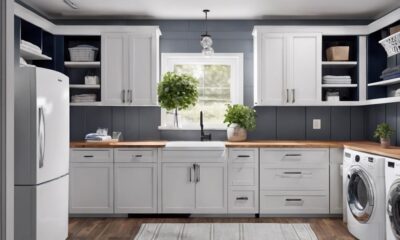Appliances
What Are the Chances of a Ceiling Fan Falling Down?
2025
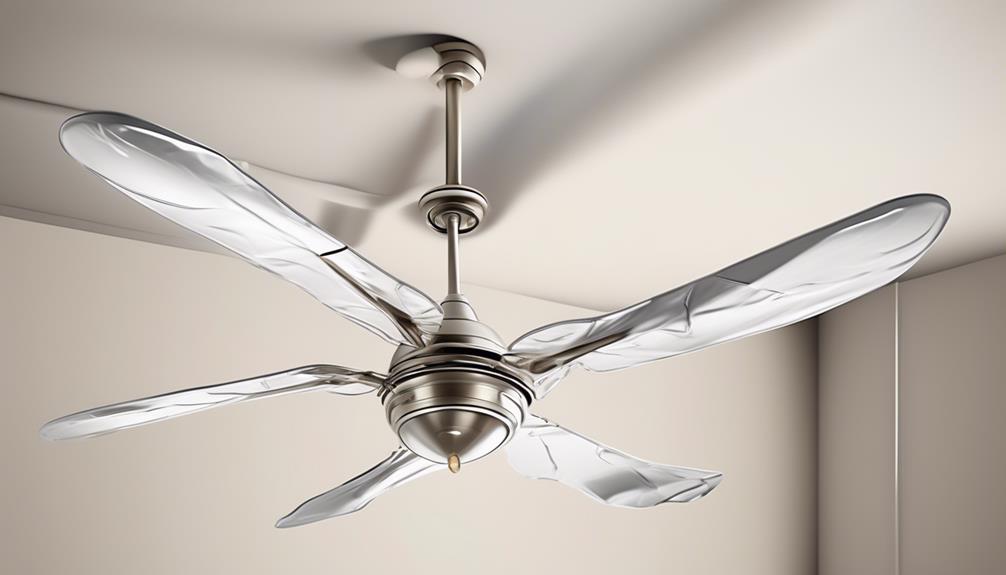
Ever pondered the likelihood of a ceiling fan plummeting down? Well, it’s not as implausible as one might imagine.
We've all seen those hilarious videos of fans crashing down, but the reality is, it can actually be quite dangerous.
In this article, we will explore the factors that contribute to the stability of ceiling fans and delve into the importance of proper installation.
We'll also discuss regular maintenance techniques that can help prevent these fans from unexpectedly plummeting from above.
So, if you're curious about the chances of a ceiling fan falling down and want to ensure your safety, keep on reading.
Key Takeaways
- Improper installation and inadequate maintenance are common causes of ceiling fan accidents and injuries.
- Factors affecting the stability of ceiling fans include proper installation, type of mounting method, high-quality blades, and regular maintenance and cleaning.
- Proper ceiling fan installation is important for secure mounting, correct electrical wiring, balanced blades, and adequate clearance to prevent damage and injuries.
- Regular maintenance, such as enhancing fan performance, cleaning blades and components, inspecting electrical connections, lubricating moving parts, and tightening screws and bolts, helps prevent ceiling fan falls.
Common Causes of Ceiling Fan Accidents
Ceiling fan accidents commonly occur due to a combination of factors, including improper installation, inadequate maintenance, and user error. To ensure ceiling fan safety, it's crucial to take necessary precautions and understand the potential risks involved.
Improper installation is a leading cause of accidents, as it can result in a fan falling down or becoming unstable. It's essential to follow the manufacturer's instructions carefully and hire a professional if needed.
Inadequate maintenance is another factor that contributes to ceiling fan accidents. Regular cleaning and inspection of the fan blades, motor, and electrical components are necessary to prevent any malfunction or failure. Neglecting maintenance can lead to the accumulation of dust and debris, which can affect the fan's balance and performance, increasing the risk of accidents.
User error is also a significant factor in ceiling fan accidents. People often underestimate the power and speed of ceiling fans, leading to careless behavior. Common injuries from ceiling fan accidents include cuts, bruises, and even more severe injuries like fractures or concussions. It's essential to educate users about the potential dangers and encourage responsible usage, such as avoiding standing on furniture near the fan or reaching for objects while the fan is in motion.
Factors Affecting the Stability of Ceiling Fans
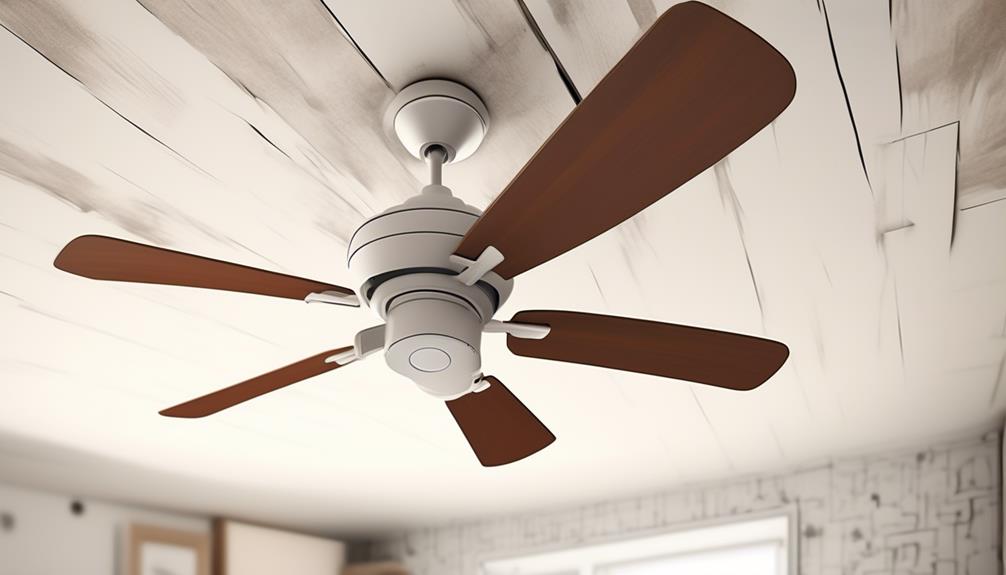
After identifying the common causes of ceiling fan accidents, it is important to examine the factors that can affect the stability of these fans. Understanding these factors is crucial in ensuring the safety of individuals who use ceiling fans. Here, we will discuss the various factors that can influence the stability of a ceiling fan and the potential dangers of unstable ceiling fans.
Factors Affecting Ceiling Fan Stability:
| Factor | Influence |
|---|---|
| Installation | Proper installation is essential for stability. An incorrectly installed ceiling fan can become unstable over time. |
| Mounting | The type of mounting method used can affect the stability of the fan. A secure mounting system is necessary to prevent wobbling or falling. |
| Blade Quality | High-quality blades are less likely to warp or become unbalanced, ensuring a stable fan operation. |
| Maintenance and Cleaning | Regular maintenance and cleaning can prevent the accumulation of dust and debris, which can affect the fan's stability. |
Potential Dangers of Unstable Ceiling Fans:
- Falling objects: An unstable ceiling fan can cause the fan blades or other components to detach and fall, posing a risk of injury to individuals below.
- Electrical hazards: An unstable fan may cause the electrical connections to become loose or damaged, increasing the risk of electrical shocks or fires.
- Noise and vibrations: Unstable ceiling fans tend to produce more noise and vibrations, leading to discomfort and annoyance for users.
Importance of Proper Ceiling Fan Installation
Proper installation of a ceiling fan is of utmost importance to ensure its stability and prevent potential hazards. When it comes to ceiling fan installation, there are common mistakes that can have serious consequences if not addressed properly.
Here are four crucial points to consider when installing a ceiling fan:
- Secure Mounting: Ensuring that the fan is securely mounted to the ceiling is essential. Improper mounting can result in the fan becoming loose over time, increasing the risk of it falling down. This can cause damage to property or even injure individuals in the vicinity.
- Electrical Wiring: Correctly wiring the ceiling fan is vital to prevent electrical hazards. Faulty wiring can lead to short circuits, fires, or even electric shocks. It's crucial to follow the manufacturer's instructions and consult a professional if unsure about the wiring process.
- Balanced Blades: Balancing the fan blades is a critical step in proper installation. Unbalanced blades can cause excessive vibrations, leading to increased wear and tear on the fan's components. This imbalance can also cause the fan to wobble, potentially detaching it from the ceiling.
- Adequate Clearance: Ensuring there's sufficient clearance between the fan blades and surrounding objects is essential. Improper clearance can result in the fan blades hitting furniture, walls, or even people, causing damage or injury.
Regular Maintenance to Prevent Ceiling Fan Falls

When ensuring the stability of a ceiling fan and preventing potential hazards, regular maintenance plays a critical role in preventing ceiling fan falls. Proper maintenance not only enhances the performance and longevity of your ceiling fan but also ensures the safety of the occupants in the space. By following the recommended maintenance guidelines, you can significantly reduce the risk of a ceiling fan falling down.
To help you understand the importance of regular maintenance and the safety precautions involved, here is a table outlining key maintenance tasks:
| Maintenance Task | Frequency | Safety Precautions |
|---|---|---|
| Tightening Screws | Every 6 months | Turn off power and use a screwdriver |
| Cleaning Blades | Every 3 months | Use a ladder and a soft cloth or brush |
| Lubricating Bearings | Annually | Switch off fan and apply lubricant |
| Inspecting Mounting | Every 12 months | Use a ladder and ensure secure attachment |
Tips for Ensuring Ceiling Fan Safety
Regular maintenance is essential for ensuring the safety of your ceiling fan and preventing any potential hazards. To maintain the safety of your ceiling fan, follow these tips:
- Inspect the fan regularly: Regularly inspect your ceiling fan for any signs of wear and tear, such as loose screws, damaged blades, or wobbly movements. Address any issues immediately to prevent further damage or accidents.
- Clean the fan regularly: Dust and dirt can accumulate on the blades and motor of your ceiling fan, affecting its performance and potentially causing overheating. Clean your fan regularly using a soft cloth or a brush to remove any dirt or debris.
- Tighten all screws and connections: Over time, the screws and connections of your ceiling fan may become loose due to the constant movement. Regularly check and tighten all screws and connections to ensure that the fan is securely mounted to the ceiling and that there are no loose parts.
- Select the right ceiling fan: When choosing a ceiling fan, ensure that it's suitable for the size of your room and ceiling height. Follow the manufacturer's recommendations for installation and make sure it's securely attached to a proper electrical junction box.
Is There a Possibility of My Ceiling Fan Falling Down and Causing Injury or Damage?
The likelihood of a ceiling fan falling is very low if it is properly installed and regularly maintained. However, if a fan is wobbling or making strange noises, it could be a sign of potential danger. It is important to address these issues promptly to prevent any possibility of the ceiling fan falling and causing injury or damage.
Frequently Asked Questions
How Much Weight Can a Ceiling Fan Support Before It Falls Down?
Ceiling fans have specific weight limits that determine their maximum capacity. It's crucial to understand these limits to ensure the safety of both the fan and the surrounding area. By adhering to the manufacturer's guidelines, one can prevent the risk of a ceiling fan falling down.
Safety precautions, such as regular maintenance and inspections, should also be taken into consideration. By understanding the ceiling fan weight limits and implementing proper safety measures, one can enjoy the benefits of a ceiling fan without any concerns.
Can a Ceiling Fan Fall Down Even if It Is Properly Installed?
Well, let me tell you, the chances of a properly installed ceiling fan falling down are about as likely as winning the lottery while being struck by lightning! But, accidents can happen, so it's important to be aware of common causes.
Loose screws, faulty installation, or improper maintenance can all contribute to a fan taking a nosedive. To prevent this, make sure to regularly inspect and tighten all components, follow manufacturer guidelines, and never overload the fan with heavy attachments.
Safety first, folks!
Are There Any Warning Signs That a Ceiling Fan Might Fall Down Soon?
Warning signs that a ceiling fan might fall down soon include:
- Excessive wobbling or shaking
- Unusual noises
- Loose screws
Regular maintenance can help prevent these issues. It's important to:
- Check and tighten all fasteners
- Inspect the fan blades for any cracks or damage
- Ensure that the fan is properly balanced
Following these maintenance tips can greatly reduce the chances of a ceiling fan falling down, providing peace of mind and ensuring the safety of your space.
What Should I Do if My Ceiling Fan Starts to Wobble?
If our ceiling fan starts to wobble, it's crucial that we address the issue promptly to prevent any potential hazards.
The most common causes of ceiling fan wobbling include loose screws, unbalanced blades, and improper installation.
To rectify the situation, we should first tighten all the screws connecting the fan to the ceiling. If the wobbling persists, we may need to balance the fan blades or seek professional assistance.
Regular ceiling fan maintenance is essential to ensure their safe operation.
Can a Ceiling Fan Fall Down Even if It's Not in Use?
Ceiling fan maintenance is crucial to prevent accidents. Common causes of ceiling fan accidents include improper installation, loose screws, and worn out parts. Even if a ceiling fan isn't in use, there's still a chance it can fall down. Over time, the fan's components can deteriorate, leading to instability.
Regularly inspecting and maintaining your ceiling fan, such as tightening screws and checking for any signs of wear and tear, can help minimize the risk of a ceiling fan falling down.
Conclusion
In conclusion, the chances of a ceiling fan falling down can be minimized through proper installation, regular maintenance, and adherence to safety precautions.
Like a skilled conductor orchestrating a symphony, we must ensure that all the factors affecting the stability of ceiling fans are harmoniously balanced. By doing so, we can enjoy the gentle breeze and soothing ambiance they provide without worrying about the potential dangers they may pose.
- About the Author
- Latest Posts
Introducing Ron, the home decor aficionado at ByRetreat, whose passion for creating beautiful and inviting spaces is at the heart of his work. With his deep knowledge of home decor and his innate sense of style, Ron brings a wealth of expertise and a keen eye for detail to the ByRetreat team.
Ron’s love for home decor goes beyond aesthetics; he understands that our surroundings play a significant role in our overall well-being and productivity. With this in mind, Ron is dedicated to transforming remote workspaces into havens of comfort, functionality, and beauty.
Garage Door Opener
Clearance Garage Door Opener Installation Guide
Navigate the complexities of installing a garage door opener with ample overhead clearance, uncovering the key steps for a seamless setup.
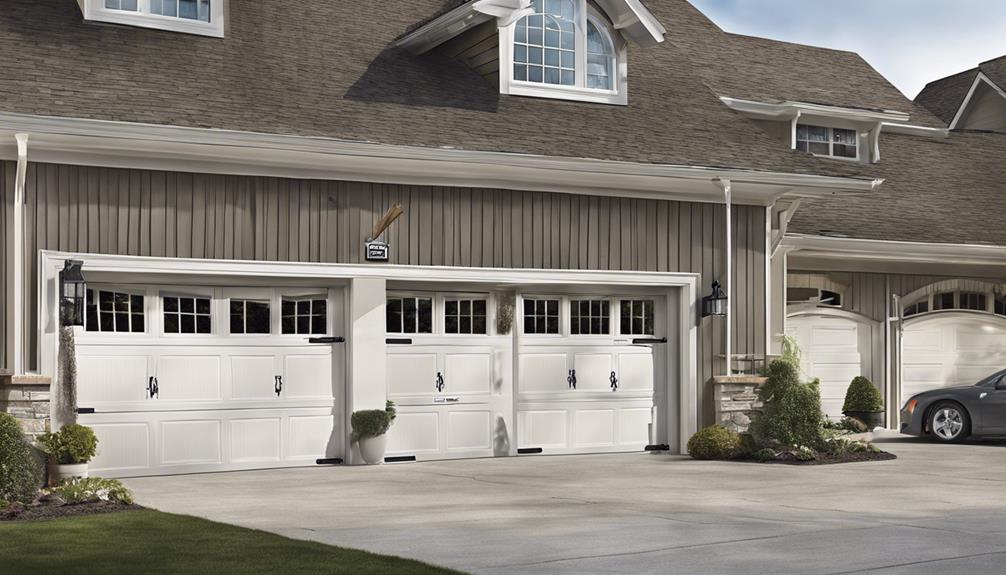
Have you ever thought about the details involved in installing a garage door opener with enough overhead clearance? How difficult is it to make sure the installation is smooth and guarantees the best performance? Well, don’t worry, as we will walk you through the necessary steps for getting your garage door opener set up.
From measuring overhead space to selecting the right opener and testing its functionality, our discussion will equip you with the necessary knowledge to tackle this task effectively. Let's unravel the secrets to a successful garage door opener installation together.
Key Takeaways
- Accurate measurement and ample clearance space are crucial for smooth installation.
- Choose a low-profile opener for limited headroom, featuring modern connectivity and quiet operation.
- Prepare a clutter-free workspace with proper lighting for efficient installation.
- Test functionality thoroughly, adjusting as needed for safe and optimal garage door operation.
Measure Overhead Clearance Space
To ensure proper installation of the garage door opener, it's crucial to accurately measure the overhead clearance space between the top of the garage door and the ceiling. The vertical space is essential for the garage door opener and its components to operate smoothly and without any hindrances.
When measuring the overhead clearance, take into account the drive garage door opener's specifications provided by the manufacturer. These specifications will outline the required vertical space needed for the specific model being installed. Additionally, consider any extra accessories or modifications that may impact the overhead clearance space, ensuring that there's ample room for safe and efficient operation.
Select Low-Profile Garage Door Opener
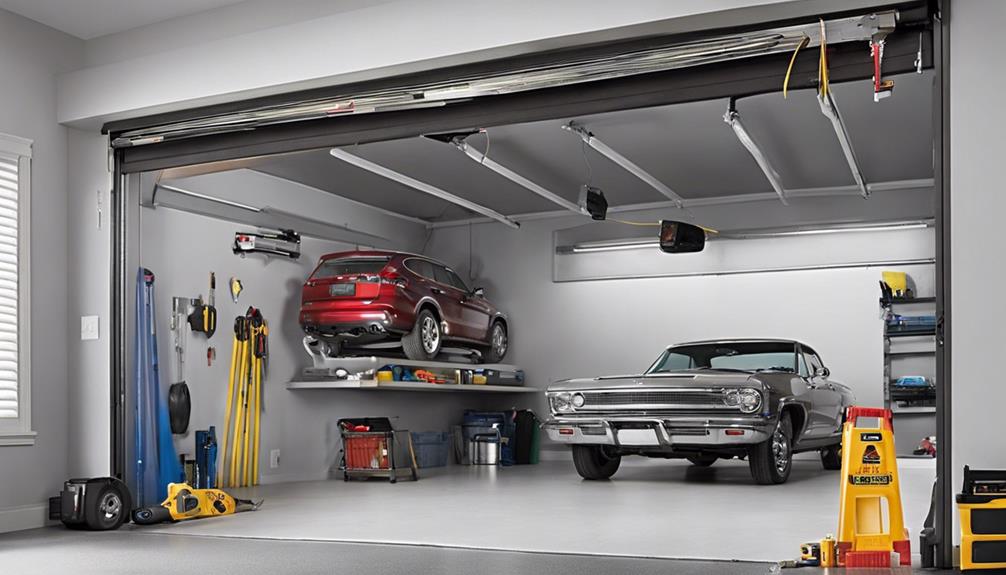
Having ensured the adequate overhead clearance space for the garage door opener installation, the next step is to carefully select a low-profile garage door opener that fits snugly in tight spaces while offering advanced features and compatibility with various door types.
Low-profile garage door openers are specifically designed to accommodate limited headroom situations, making them perfect for garages with space constraints. Their compact and sleek design allows for discreet installation without occupying much room. These openers often come equipped with modern conveniences like smartphone connectivity, battery backup, and quiet belt drive operation for a seamless user experience. Additionally, their compatibility with a range of garage door sizes and types provides installation flexibility.
Energy efficiency is another advantage, as low-profile garage door openers can help reduce electricity consumption, leading to potential long-term cost savings. When choosing a low-profile garage door opener, consider factors such as the size of your garage door and the desired features for optimal performance.
Prepare Workspace for Installation
Clearing the area around the garage door opener is essential to provide ample space for a smooth installation process. Before beginning the installation of the garage door opener, it's crucial to ensure that there are no obstructions or clutter that may hinder the process.
By creating a clean and organized workspace, you can work efficiently and safely. Remove any tools or items that may interfere with the installation of the garage door opener to streamline the process. Keeping the workspace well-lit and free from distractions will allow you to focus on the installation tasks at hand.
Install Opener According to Manual
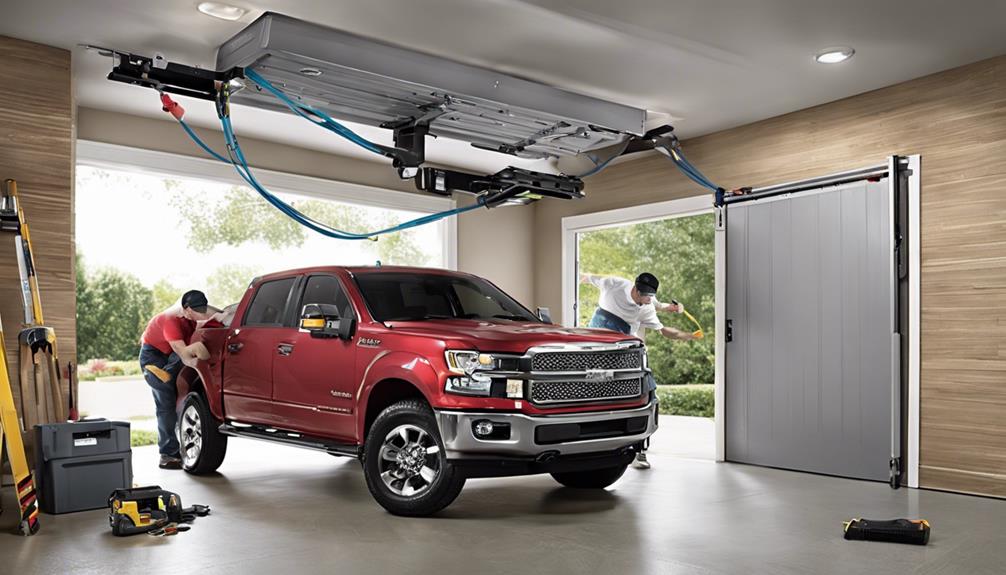
Following the manufacturer's manual meticulously is crucial for the precise installation of the garage door opener. To ensure a successful installation, our team recommends the following steps:
- Positioning Components: Properly position and secure all garage door opener components as instructed in the manual. This ensures the safe and efficient operation of the opener.
- Connecting Wiring: Connect all wiring and mechanisms according to the manual's specifications. Proper connection is vital to prevent malfunctions and ensure smooth functioning of the garage door.
- Adhering to Guidelines: Adhere strictly to the manual's guidelines for installing the opener. These guidelines are designed by professional garage door experts to guarantee a correct and secure installation.
Test Functionality and Adjust if Needed
To ensure the garage door opener functions smoothly and safely, thorough testing and potential adjustments are essential. Begin by testing the garage door's opening and closing functionality multiple times to guarantee a seamless operation.
Listen for any unusual sounds and watch out for jerky movements or obstructions that may impede the door's movement. If any issues arise, consider adjusting the opener's settings to enhance the door's operation and clearance within the garage space.
It's crucial to verify that the door clears the opening without any problems or interference. Additionally, confirm that the safety sensors are operational and don't hinder the door's movement in any way, ensuring a safe and efficient garage door operation.
Frequently Asked Questions
How Much Clearance Do You Need to Install a Garage Door Opener?
We need a minimum of 2 inches of clearance above the garage door for installing most openers. It's crucial to check the manufacturer's specifications for the exact clearance required by your specific opener model.
Taller doors or special opener features may demand more clearance. The needed space can vary depending on the opener type, like chain-drive, belt-drive, or screw-drive.
Adequate clearance ensures smooth opener operation and prevents door movement interference.
What Is the Minimum Clearance Above a Garage Door for an Opener?
We need at least 2 inches of clearance above a garage door for an opener to work effectively. Some models might require up to 3 inches, depending on their design. Too little space can lead to operational issues and potential damage.
It's crucial to measure accurately before installing to avoid problems. Always refer to the manufacturer's guidelines for the specific opener model to ensure the right clearance.
How Much Does Lowes Charge to Install a Garage Door Opener?
We love the convenience of Lowe's garage door opener installation services, starting at $127, with pricing varying based on installation complexity.
Extra charges may apply for services like removing old openers or installing new electrical outlets. Remember, the installation cost doesn't include the price of the garage door opener itself, which must be purchased separately.
Rest assured, Lowe's provides professional installation by licensed and insured contractors for peace of mind.
How Close Do You Have to Be for Garage Door Opener?
We need to be within 25-35 feet for the garage door opener to work.
Sensors should be placed 4-6 inches above the floor to detect obstacles.
Some models offer Wi-Fi connectivity, enabling remote access.
Advanced features like battery backup ensure operation during power outages.
These key factors influence how close we must be for the garage door opener to function effectively.
Conclusion
In conclusion, installing a low-profile garage door opener is like fitting a key into a lock – precise, smooth, and essential for seamless operation.
By following the detailed steps in the clearance garage door opener installation guide, you can ensure your opener functions flawlessly and efficiently.
Remember to test the functionality and make any necessary adjustments for optimal performance.
With proper installation and maintenance, your garage door opener will open up a world of convenience for you.
- About the Author
- Latest Posts
Introducing Ron, the home decor aficionado at ByRetreat, whose passion for creating beautiful and inviting spaces is at the heart of his work. With his deep knowledge of home decor and his innate sense of style, Ron brings a wealth of expertise and a keen eye for detail to the ByRetreat team.
Ron’s love for home decor goes beyond aesthetics; he understands that our surroundings play a significant role in our overall well-being and productivity. With this in mind, Ron is dedicated to transforming remote workspaces into havens of comfort, functionality, and beauty.
Garage Door Opener
What Makes the Glink Garage Door Opener Stand Out?
Outstanding safety features and user-friendly functionalities distinguish the Glink Garage Door Opener – but what else makes it a game-changer?
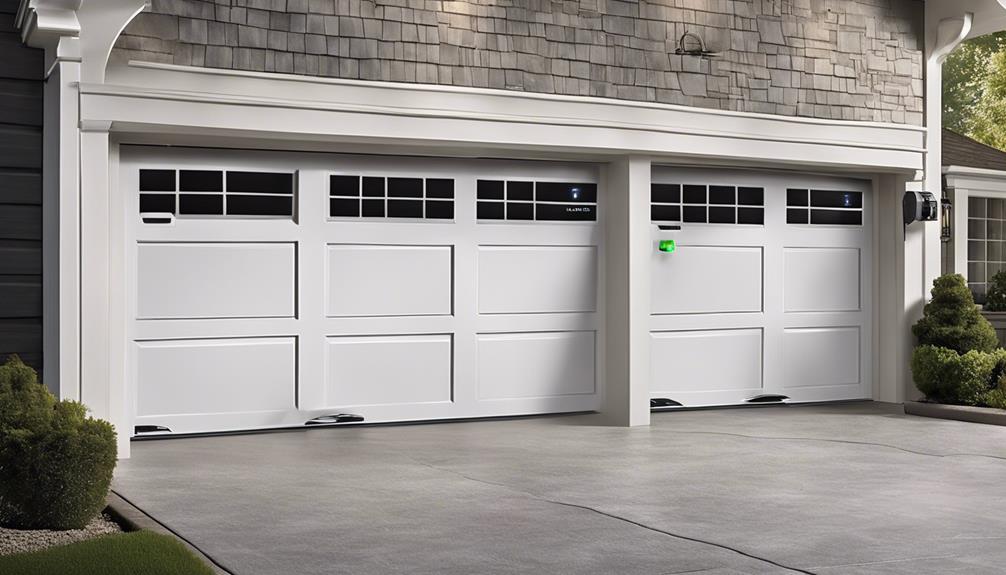
When it comes to garage door openers, the Glink Garage Door Opener really stands out. Its unparalleled level of innovation and attention to detail in features sets it apart in the market.
From cutting-edge safety measures to user-friendly functionalities, the Glink Garage Door Opener has redefined what we expect from this essential home device.
But what exactly makes it stand out from the rest? Let's explore further.
Key Takeaways
- Built-in camera for live monitoring adds security and convenience.
- Belt-driven openers ensure quiet performance for a peaceful environment.
- Advanced Wi-Fi connectivity allows for remote access and smart home integration.
- High-grade steel construction and advanced motor technology ensure durability and reliability.
Innovative Features of Glink Garage Door Opener
The Glink Garage Door Opener revolutionizes home security with its cutting-edge built-in camera for live monitoring capabilities, setting a new standard in garage door technology. When it comes to garage door maintenance, one crucial aspect is the proper lubrication of moving parts to ensure smooth operation. The Glink opener excels in this area by incorporating a sophisticated spring system that enhances the overall functionality and longevity of the garage door.
Furthermore, the Glink Garage Door Opener is designed with belt-driven openers that not only reduce the noise during operation but also provide a more reliable performance compared to chain-driven systems. This innovative feature enhances the user experience by offering a quieter and more efficient operation that's essential for modern homeowners seeking convenience and peace of mind.
User-Friendly Design Highlights

Featuring intuitive controls and seamless integration with smart home systems, the user-friendly design of the Glink Garage Door Opener offers unparalleled convenience and security for homeowners. Here are some highlights that make it stand out:
- Easy-to-Use Controls: The Glink Garage Door Opener provides straightforward controls, allowing users to operate their garage doors with ease.
- Smart Home Integration: With compatibility for smart home systems, users can conveniently monitor and control their garage doors remotely using their smartphones or voice commands.
- Safety Sensors: Equipped with advanced safety sensors, the opener detects obstacles in the door's path, ensuring the safety of both people and property.
- Quiet Operation: The Glink Garage Door Opener operates quietly, making it ideal for garages attached to living spaces where noise reduction is essential.
The straightforward installation and setup process further enhance the user-friendly experience, making the Glink Garage Door Opener a hassle-free addition to any home.
Reliable Performance Factors
Among the standout features of the Glink Garage Door Opener, its reliable performance factors set a high standard in the realm of garage door operation and security.
The Glink Garage Door Opener utilizes DC motors, which provide efficient and smooth operation, especially when paired with a belt-driven garage door mechanism. This combination not only ensures a reliable performance but also contributes to reducing the noise level during door operation, making it ideal for homes where noise pollution is a concern.
Additionally, the inclusion of a safety sensor system enhances the overall reliability of the opener by detecting any obstructions and prompting the door to stop and reverse its motion, prioritizing user safety.
Moreover, the smart technology integration allows for convenient control and monitoring of the garage door opener remotely, adding an extra layer of security and accessibility.
The Glink Garage Door Opener's reliable performance factors make it a top choice for those seeking a dependable and efficient garage door solution.
Glink Garage Door Opener Durability
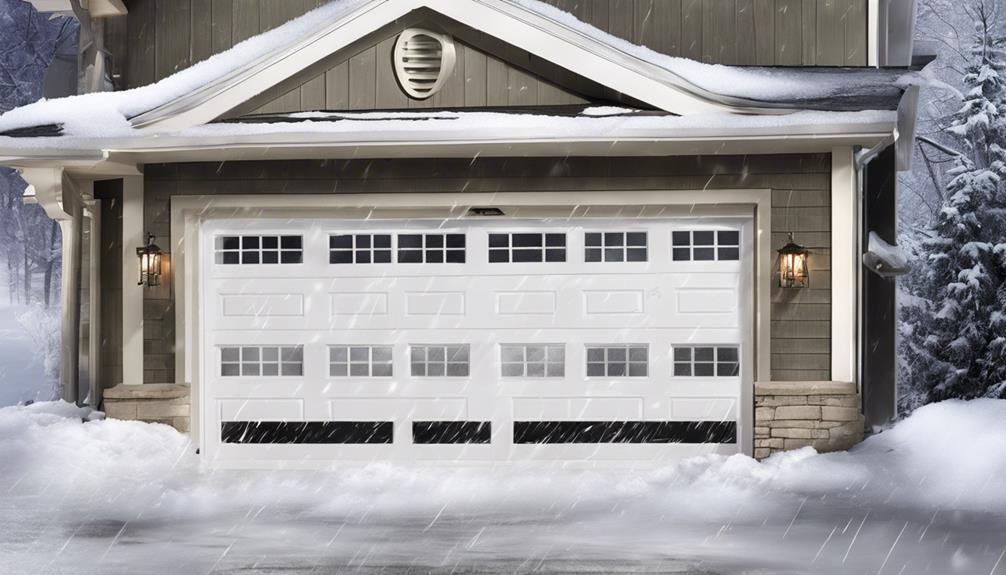
How does the durability of the Glink Garage Door Opener compare to other models on the market? When it comes to lasting strength and reliability, the Glink Garage Door Opener stands out from the competition. Here's why:
- Durable Materials: Crafted from high-grade steel and reinforced components, the Glink Garage Door Opener is built to withstand the test of time, ensuring longevity and robust performance.
- Advanced Motor Technology: Equipped with cutting-edge motor technology, this opener delivers powerful and efficient operation, enhancing its durability and overall functionality.
- Residential Garage Door Operation: Designed specifically for residential use, the Glink Garage Door Opener is tailored to meet the demands of daily home access, supporting consistent and reliable performance.
- Minimal Maintenance Requirements: With a focus on user convenience, this opener requires minimal maintenance, allowing homeowners to enjoy hassle-free operation without frequent upkeep tasks.
Standout Technology in Glink Opener
The advanced Wi-Fi connectivity of the Glink Garage Door Opener sets it apart in the realm of smart home technology, offering users convenient remote access to their garage door from any location. This feature enables seamless control through the Glink mobile app, empowering users to monitor and manage their garage door with just a few taps on their smartphone. Moreover, the Glink Opener's compatibility with voice assistants such as Amazon Alexa and Google Assistant adds a layer of hands-free convenience, allowing users to operate their garage door effortlessly using voice commands.
The integration of smart technology in the Glink Garage Door Opener further enhances its standout features. Through real-time alerts and notifications, users are kept informed about the status of their garage door, enhancing both security and peace of mind. Additionally, the ability to schedule automatic opening and closing times streamlines daily routines, making the overall user experience more efficient and tailored to individual preferences. The Glink Opener truly represents a modern approach to garage door operation, combining innovation with practicality for a liberating user experience.
Frequently Asked Questions
How Can I Boost My Garage Door Opener Signal?
To boost our garage door opener signal, we can take several steps.
Reposition the antenna for better reception and remove any obstructions blocking the signal.
Upgrading to a dual-frequency remote control can enhance signal strength.
Installing a repeater or range extender can amplify the signal.
Checking for interference from nearby electronics is crucial to ensure a smooth signal transmission.
These steps can help improve the overall performance of our garage door opener system.
Which Is Better a Chain or Belt Garage Door Opener?
When comparing a chain and belt garage door opener, it's crucial to consider factors like noise level, cost, reliability, and durability based on personal needs.
Chain openers are cost-effective and robust, ideal for heavy doors or high-traffic areas.
On the other hand, belt openers offer quieter operation and require less maintenance.
Ultimately, the choice depends on individual preferences, budget constraints, and specific garage door requirements.
What Is the Best Residential Garage Door Opener?
When it comes to choosing the best residential garage door opener, safety features like automatic reversing and rolling code technology are crucial. Battery backups ensure operation during power outages, while security lights provide added safety. Consider different types such as chain-driven, belt-driven, screw-driven, direct drive, and jackshaft models.
LiftMaster series like 8365, Elite Series 8550 DC, and 8500 offer excellent features for residential use, catering to various needs.
How Much Horsepower Do I Need for a 2 Car Garage Door?
We've got the know-how on garage door openers! A 1/2 horsepower opener is typically enough for a standard 2 car garage door.
If you've got a heavier or insulated door, consider bumping up to a 3/4 or 1 horsepower for optimal performance. The right horsepower ensures smooth operation and longevity for your opener.
Consult a pro to determine the best fit for your specific garage door setup.
Conclusion
In conclusion, the Glink Garage Door Opener truly shines with its innovative features, user-friendly design, reliable performance, and durability.
It stands out in the market for its advanced safety technology and standout features like automatic reversing and rolling code encryption.
With the Glink Garage Door Opener, you can rest assured that your garage door will operate smoothly and securely.
It's like having a guardian angel watching over your home's entrance.
- About the Author
- Latest Posts
Introducing Ron, the home decor aficionado at ByRetreat, whose passion for creating beautiful and inviting spaces is at the heart of his work. With his deep knowledge of home decor and his innate sense of style, Ron brings a wealth of expertise and a keen eye for detail to the ByRetreat team.
Ron’s love for home decor goes beyond aesthetics; he understands that our surroundings play a significant role in our overall well-being and productivity. With this in mind, Ron is dedicated to transforming remote workspaces into havens of comfort, functionality, and beauty.
Garage Door Opener
Silencing Your Garage Door Opener Humming: A Step-by-Step Guide
Discover how to silence your garage door opener humming with expert tips and tricks, transforming your space into a noise-free haven.

We’ve got you covered with practical steps to tackle the noise when it comes to silencing your garage door opener humming.
From pinpointing the source of the hum to exploring maintenance techniques, our guide offers a comprehensive approach to quieting your garage door opener.
By implementing these methods, you can create a peaceful environment without the constant background hum.
So, are you ready to transform your garage into a serene space?
Key Takeaways
- Inspect transformer for issues in Legacy 850/Standard Drive 650 models.
- Tighten all hardware components to minimize vibrations and humming.
- Regularly lubricate moving parts to reduce friction and noise.
- Adjust opener settings for optimized force and smooth operation.
Identifying the Source of Humming
To pinpoint the source of the humming noise in your garage door opener, start by examining the transformer located in the motor head for any signs of malfunction. The transformer is crucial for converting incoming power to the appropriate voltage needed to operate the DC motors in garage door openers like the Legacy 850 or Standard Drive 650.
If you own one of these models and notice a persistent humming sound, the transformer may be the culprit. For Legacy 850 or Standard Drive 650 units with a date code before 15198, replacing the transformer (part #39342RS) is often the solution. These replacement transformers for Overhead Door model openers can be easily sourced from www.OverheadDoorPartsOnline.com.
If you encounter any challenges during the replacement process or need further assistance, don't hesitate to reach out to your local Overhead Door distributor at 1-800-929-3667 for expert technical support. Identifying and addressing issues with the transformer can help silence the humming and ensure smooth operation of your garage door opener.
Inspecting and Tightening Hardware

Inspecting and tightening the hardware components of your garage door opener is crucial to identifying and addressing potential sources of humming noise. Begin by checking for loose nuts, bolts, and screws on the opener. Using a wrench, tighten all hardware components securely to reduce vibrations and minimize humming. Ensure that the mounting brackets, chains, and railings are properly fastened to prevent unnecessary movement and humming. It's also essential to inspect the motor head and drive system for any loose parts that could be causing the humming sound.
Regularly tightening and securing the hardware of your garage door opener is key to maintaining a quiet and efficient operation. Loose components can lead to increased vibrations and noise levels. By keeping all nuts, bolts, screws, mounting brackets, chains, railings, and motor head properly tightened, you can significantly reduce the humming noise coming from your garage door opener. This simple maintenance task can make a big difference in the overall performance of your garage door system.
Lubricating Moving Parts
When lubricating the moving parts of your garage door opener to reduce humming noise, ensure thorough coverage using a garage door lubricant or silicone-based option. Regular maintenance of your garage door opener includes proper lubrication of its moving parts such as the chain, belt, or screw drive. This lubrication helps reduce noise by preventing excess friction between the components. To assist you in understanding which lubricant to use and where to apply it, refer to the table below:
| Moving Parts | Recommended Lubricant |
|---|---|
| Chain Drive | Garage Door Lubricant |
| Belt Drive | Silicone-Based Lubricant |
| Screw Drive | Garage Door Lubricant |
Adjusting Garage Door Opener Settings

Adjust garage door opener settings to minimize humming noise by accessing the control panel and fine-tuning force and travel limits. Here's how to do it:
- Access the Control Panel:
- Locate the control panel on your garage door opener, usually found near the motor unit.
- Open the panel cover to reveal the adjustment settings.
- Adjust Force Settings:
- Use a flathead screwdriver to adjust the force settings on the opener.
- Increase or decrease the force to find the optimal setting that reduces resistance and noise.
- Fine-Tune Travel Limits:
- Locate the travel limit adjustment screws on the control panel.
- Gradually adjust the travel limits for both opening and closing directions.
- Test the door after each adjustment to ensure it opens and closes smoothly without excessive noise.
Seeking Professional Help
For addressing unusual humming sounds in your garage door opener, it is advisable to seek professional assistance from a certified technician. When dealing with a persistent humming noise coming from your garage door opener, it is crucial to involve experts who can accurately diagnose and resolve the issue. Certified technicians have the knowledge and experience to identify the source of the unusual sound and provide appropriate solutions to eliminate it effectively.
To guide you in understanding the benefits of seeking professional help, refer to the table below:
| Benefits of Seeking Professional Help | |
|---|---|
| 1. Expert Diagnosis | Certified technicians can pinpoint the exact cause of the humming noise. |
| 2. Precise Resolution | Professionals offer targeted solutions to resolve the issue efficiently. |
| 3. Technical Support | Get access to specialized assistance for your garage door opener complications. |
| 4. Prevent Further Damage | Avoid potential harm by allowing trained professionals to handle the motor head. |
When faced with a garage door opener humming problem, don't hesitate to reach out to a certified technician for technical support and expert troubleshooting.
Frequently Asked Questions
How Do I Silence My Garage Door Opener?
To silence your garage door opener, locate the source of the noise, which may be the motor head. Check the transformer for any issues causing the humming sound.
If you have a Legacy 850 or similar model, consider replacing the transformer part. For specific parts and guidance, visit OverheadDoorPartsOnline.com or reach out to a local distributor for assistance.
This process will help eliminate the unwanted noise from your garage door opener.
Why Is My Garage Door Opener Making a Humming Noise?
We discovered why our garage door opener is humming. It seems the culprit might be a faulty transformer in the motor head.
This issue is common in garage door openers with DC motors like the Overhead Door Phantom (777CD) and Legacy 850 (2029). If you have a Legacy 850 with a date code before 15198, replacing the transformer (part #39342RS) could be the fix.
Look for replacement transformers at www.OverheadDoorPartsOnline.com or call 1-800-929-3667 for help.
How Do I Make My Garage Door Not Loud?
To make our garage door not loud, we can start by lubricating the moving parts to reduce noise from friction. Check for loose chains or belts that might be causing the loudness.
Upgrading to a belt-driven opener can also help for quieter operation. Inspect the motor head for loose components.
If the noise persists, it's best to seek help from a professional technician for an effective solution.
How Do I Stop My Electric Buzzing?
If you're looking to halt that electric buzzing, we've got you covered.
First, pinpoint the source of the sound, often linked to a malfunctioning transformer in the motor head. Models like the Overhead Door Phantom (777CD) and Legacy 850 (2029) with DC motors commonly face this issue.
For specific models like the Legacy 850 or Standard Drive 650 predating 15198, think about replacing the transformer (part #39342RS).
Need replacement transformers? Check out www.OverheadDoorPartsOnline.com.
Conclusion
In conclusion, by following the steps outlined in this guide, we can effectively address the issue of garage door opener humming and ensure a more peaceful and efficient operation.
Remember, with regular maintenance and proper care, we can achieve a quieter and smoother functioning garage door opener.
Don't hesitate to seek professional assistance if needed, as it can further enhance the performance of your garage door system.
- About the Author
- Latest Posts
Introducing Ron, the home decor aficionado at ByRetreat, whose passion for creating beautiful and inviting spaces is at the heart of his work. With his deep knowledge of home decor and his innate sense of style, Ron brings a wealth of expertise and a keen eye for detail to the ByRetreat team.
Ron’s love for home decor goes beyond aesthetics; he understands that our surroundings play a significant role in our overall well-being and productivity. With this in mind, Ron is dedicated to transforming remote workspaces into havens of comfort, functionality, and beauty.
-

 Decor2 weeks ago
Decor2 weeks agoMaximalist Decor Explained: Embrace More Style
-

 Vetted2 weeks ago
Vetted2 weeks ago15 Best Foot Massagers for Neuropathy to Soothe Your Feet and Relieve Discomfort
-

 Vetted3 weeks ago
Vetted3 weeks ago15 Best Sports Laundry Detergents for Keeping Your Activewear Fresh and Clean
-

 Vetted3 weeks ago
Vetted3 weeks ago15 Best Tall Toilets for Seniors That Combine Comfort and Safety
-

 Vetted4 weeks ago
Vetted4 weeks ago15 Best Dish Scrubbers to Keep Your Kitchen Sparkling Clean
-

 Vetted3 days ago
Vetted3 days ago15 Best Cleaners for Fiberglass Showers to Keep Your Bathroom Sparkling Clean
-

 Decor4 weeks ago
Decor4 weeks agoWhat Is Eclectic Home Decor
-

 Vetted1 week ago
Vetted1 week ago15 Best Organic Pest Control Solutions for a Naturally Pest-Free Home












